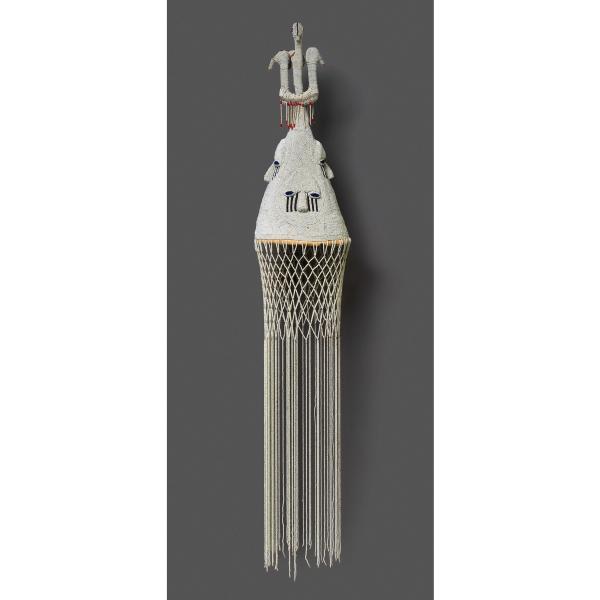Adéńlá (big crown)
Artwork Details
- Title: Adéńlá (big crown)
- Artist: Yoruba bead artist
- Date: Late 19th–early 20th century
- Geography: Southwest Nigeria
- Culture: Yoruba peoples
- Medium: Glass beads, thread, cloth, mixed media offerings
- Dimensions: H. 54 1/4 in. x W. 9 3/4 in. x W. 9 3/4 in.
- Classification: Textiles-Beadwork
- Credit Line: Gift of Carol B. Kenney, in memory of Jerome P. Kenney, 2025
- Object Number: 2025.97.1
- Curatorial Department: The Michael C. Rockefeller Wing
Audio

1551. Adéńlá (big crown), Yoruba bead artist
Jacob Kehinde Olupona
JACOB KEHINDE OLUPONA: These material objects, they are not really objects. They’re sacred entities that have life. They have power, just like the king.
ANGELIQUE KIDJO (NARRATOR): This crown is a testament to the brilliance of artists specializing in sacred beadwork in both southwestern Nigeria and the Republic of Benin. But it also points to the power of a work of art to transform and transcend the material world and the people in it.
Jacob Kehinde Olupona, professor of African and African American Studies at Harvard.
JACOB KEHINDE OLUPONA: The veils cover the face of the king when the crown is worn. Through this concealment, those who are looking at the king will be aware that they are before a god. And the king, who is also looking at the people through this crown, is looking at not just his subject, he’s also aware that they are powerful people. They’re diviners, they’re medicine men and medicine women, they are people who make it possible for him to stay on the throne.
The birds that often appear on top of the crown—they symbolize the power of our mothers. The power of the feminine. It is also through their benevolence that the king is able to govern his people in justice and fairness.
So the king’s aware that he’s enjoined to temper that power and authority so that he doesn’t misuse it. Because if he misuses it, then there may be repercussions. So that’s the beauty of this tradition. Power is sacred. Power must also be tamed and curtailed.
###
Music:
“Agolo”
Performed by Angelique Kidjo
Courtesy of Island Records under license from Universal Music Enterprises
“Agolo”
By Jean Louis Pierre Hebrail and Carmen Angelique Kidjo
Warner Chappell Music France SA (SACEM)
All rights on behalf of Warner Chappell Music France SA administered by WC Music Corp.
More Artwork
Research Resources
The Met provides unparalleled resources for research and welcomes an international community of students and scholars. The Met's Open Access API is where creators and researchers can connect to the The Met collection. Open Access data and public domain images are available for unrestricted commercial and noncommercial use without permission or fee.
To request images under copyright and other restrictions, please use this Image Request form.
Feedback
We continue to research and examine historical and cultural context for objects in The Met collection. If you have comments or questions about this object record, please contact us using the form below. The Museum looks forward to receiving your comments.